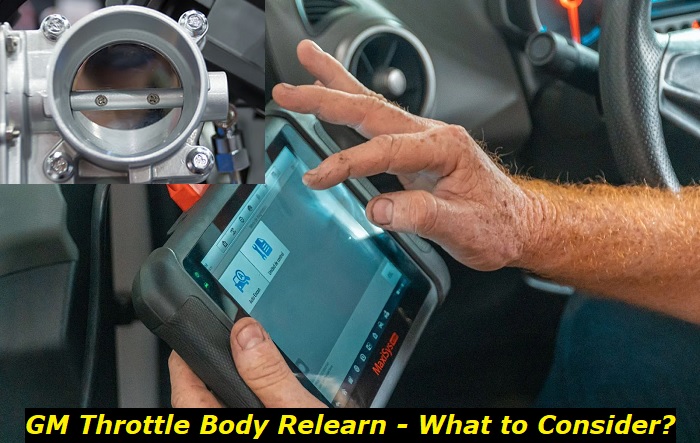The throttle body is among the car components that require constant attention if your GM vehicle has exceeded 75,000 miles. Many people accidentally affect their ECU's throttle position sensor memories when cleaning or replacing their throttle bodies. Once the ECU's memory can no longer open the throttle as required, a relearning procedure is necessary.
Electrical problems leading to RPM anomalies highlights
- DIY repairs:possible but complicated
- Tools needed:inspection and repair tools
- Commonreasons:idle control valve, throttle position sensor, wiring, software
- Time to repair:1 - 2.5 hours
- Price for parts:$50 - $300
- Can you drive?Yes
- Alternative solutions:unplugging sensors, resetting or relearning sensors

What is Your Throttle Body's Function?
Your throttle body controls the volume of air entering your engine at particular times. The throttle body has a position sensor that works with the mass air flow sensor to provide accurate data to the ECU. Your ECU then determines the right amount of fuel to supply to the engine under the conditions highlighted by the throttle position sensor and mass airflow sensor.
Your throttle body's optimal functioning may be affected by various factors. The most common cause of malfunctions is the clogging of your air intake by dirt and debris. This blockage causes your General Motors car to fail to pull sufficient fuel. You are well advised to clean your throttle body regularly to avoid blockage of your air intake.
People with experience are likely to do more harm than good when attempting to clean the throttle body and position sensor. If the throttle body and position sensor are cleaned incorrectly, you must perform a throttle body relearn. If you got into this mess by tinkering with your GM vehicle, ensure you consult your dealership or a licensed mechanic for an effective recalibration.
When is Throttle Body Relearn Necessary?
Is your car experiencing a high idle after the types of repair detailed in the previous section? If so, you have likely heard an odd and erratic sound from your GM car whenever it is idling. Malfunctions created by vacuum leaks, damaged intake hoses, and electrical or programming problems could cause the annoying idling sound. Amateur DIYers may accidentally cause a vacuum leak or damage an intake hose when cleaning their throttle position body.
If the rough idling goes away with time, you probably have nothing to worry about. If the rough idling persists, one of your internal components is likely damaged and will require professional diagnosis and repair. Ensure you attend to the problem as soon as possible. Drivers aiming to avoid costly repairs should fix the problem before rough idling causes other components to malfunction.
A trained mechanic will advise you on the best solution for you. If it is determined that your ECU has forgotten the throttle body position, a relearn will be necessary to eliminate the rough idle.
What is Throttle Body Relearn?
Throttle body relearn is also called idle relearn. It is a precise procedure that DIY drivers or professional mechanics can use to reprogram a vehicle with the right idle speed. A throttle body relearn may be necessary if your car has recently undergone repair work, e.g., disconnecting your battery, cleaning or replacing your throttle body, and clearing an engine warning light.
When repairs affect your car's idling, you will likely notice a check engine warning light and trouble codes. The poor idling may be high, low, or erratic. At times, your General Motor's car engine may stall whenever it is forced to idle, e.g., at a red light.
How Your Throttle Body and Position Sensor Operate
A drive-by-wire system has advanced throttle response; the input your throttle receives uses a signal to communicate with the ECU. The old cable systems sent this message through a wire. Your GM vehicle's ECU sends a signal to the motor, which operates the butterfly valve in your throttle body. This signal will depend on the information the ECU has received from your accelerator pedal sensor.
Your throttle opens fully when you push your accelerator pedal to the floor. If your accelerator pedal is not pressed and the car runs at idle speed, your throttle position sensor should open slightly. A slight opening ensures the engine gets enough air to prevent it from stalling. Your ECU process data from the sensors and determines whether to open the throttle fully or partially.
If your ECU 'forgets' how to keep the throttle partially open whenever your vehicle is idling, you will need to perform a throttle body relearn. Are you wondering how on earth your ECU would lose its throttle position sensor memory? Failure to do this will subject you to rough idling, increased fuel consumption, and stalling at low speeds.
Why Your Throttle Body Relearn is Not Working
Various malfunctions could cause erratic idling in your GM vehicle. The most common causes are related to your throttle position sensor. This butterfly flap is located on your engine's airway, so it controls the volume of air entering. The air volume must match the amount of fuel injected into the engine by the ECU.
The classic car design connected the butterfly valve to your accelerator pedal. Technology wiped out linkages and cables used to connect the butterfly valve to the pedal. Modern vehicles use signal cables and sensors to link the throttle position sensors and accelerator pedal. The days when the engine could be revved from the bay by hand are long gone. Modern sensors and actuators are much more effective, durable d and easy to maintain.
Reasons Your ECU Has Lost Throttle Position Sensor Memory
There are multiple scenarios that could result in your ECU losing its throttle position sensor memory. Here are some conditions that could trigger the need for a throttle body relearn:
- A recent battery replacement
- Your battery dies
- Clearing your checking engine light
- Cleaning your throttle body incorrectly
- Replacing your throttle body
Once your ECU forgets its throttle positioning, a relearn must be performed. It is the only way for the vehicle to idle optimally and quit hesitating when you push the accelerator pedal. A computerized relearn may be your best option if you have tried to perform a DIY throttle relearn without much success. You can save time, money, and effort by calling on your dealership or a reputable local repair shop to perform an effective repair.
Some Other Things You Should Consider About the Throttle Body Relearn
Anyone determined to perform their throttle relearn at home should consult their owner's manual. Every car has a precise throttle body relearn procedure. Find your vehicle instructions to ensure you follow the correct procedure for their GM model. Once you familiarize yourself with the throttle relearn instructions, be sure to follow the procedure to the letter.
There are several i's to dot and t's to cross before beginning your throttle relearn. Please take these precautions to prevent your throttle body from relearning and not working even when you follow the right procedure.
- Ensure your throttle body is clean and dry. Clean it carefully before relearning if it appears to be clogged.
- Check that your battery is well connected, in good health, and supplying 12.9V.
- Switch off all your electrical components when performing the relearn. Any external load will affect your throttle body relearning process.
Here is a simple procedure that is known to work for most GM cars:
- Start your engine and let the vehicle idle in park for about three minutes. You may notice that your idle is higher than usual, but let the clock run out.
- Turn off your engine and let it sit for about one minute.
- Start your engine again and allow it to idle in the park for another three minutes.
- As your vehicle idles, check whether your check engine light one.
- While your vehicle continues idling, connect an ODB scanner and clear any throttle body-related codes.
- If your idling state still needs to be improved, switch off the engine and give it a minute to cool down before letting it idle for three minutes.
- If your throttle body relearn is still unsuccessful, drive your car over 45 mph, ensuring you take it through enough deceleration and acceleration cycles.
- Try the above steps one final time, and if your idling remains rough, take your vehicle to the professionals for a computerized throttle body relearn.
About the authors
The CarAraC research team is composed of seasoned auto mechanics and automotive industry professionals, including individuals with advanced degrees and certifications in their field. Our team members boast prestigious credentials, reflecting their extensive knowledge and skills. These qualifications include: IMI: Institute of the Motor Industry, ASE-Certified Master Automobile Technicians; Coventry University, Graduate of MA in Automotive Journalism; Politecnico di Torino, Italy, MS Automotive Engineering; Ss. Cyril and Methodius University in Skopje, Mechanical University in Skopje; TOC Automotive College; DHA Suffa University, Department of Mechanical Engineering






Add comment